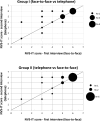Functional health literacy in a population-based sample in Florence: a cross-sectional study using the Newest Vital Sign
- PMID: 31221877
- PMCID: PMC6589023
- DOI: 10.1136/bmjopen-2018-026356
Functional health literacy in a population-based sample in Florence: a cross-sectional study using the Newest Vital Sign
Abstract
Objectives: To assess the level of functional health literacy (HL) and its antecedents and consequences in an adult population-based sample, using the Italian version of Newest Vital Sign (NVS-IT).
Design: Cross-sectional study.
Setting: General population.
Participants: 984 people were randomly selected from the resident registers of 11 general practitioners; a total of 452 (46.2%) of the selected people completed the study. Inclusion criteria were the following: 18-69 years of age and Italian speaking. Exclusion criteria included cognitive impairment, severe psychiatric diseases and end-stage diseases.
Outcome measures: HL levels as assessed by the NVS-IT and the following potential HL predictors and consequences were assessed using logistic regression models: sociodemographic characteristics, body mass index, presence of long-term illnesses, self-reported health status, health services use in the last 12 months.
Results: High likelihood of limited HL, possibility of limited HL and adequate HL were found in 11.5%, 24.6% and 63.9% of the sample, respectively. The results of the multivariate logistic model for the antecedents showed that the risk of having high likelihood or possibility of limited HL levels increases with age (OR 1.07, 95% CI 1.05 to 1.09), lower educational level (OR 4.03; 95% CI 3.41 to 7.49) and with worse financial situation (OR 1.64; 95% CI 1.17 to 2.63). As far as health outcomes are concerned, HL resulted to be positively associated with self-reported health status (OR 2.25, 95% CI 1.75 to 2.75).
Conclusions: Findings show a good level of functional HL in the population. However, older, less educated and poorer population groups showed to have a higher likelihood of suffering from limited or inadequate HL. Efforts should be made to design and implement public health policies and interventions tailored to different HL levels.
Trial registration number: CEAVC:10113.
Keywords: antecedents and consequences; functional health literacy; newest vital sign; population-based sample; public health; telephone interview.
© Author(s) (or their employer(s)) 2019. Re-use permitted under CC BY-NC. No commercial re-use. See rights and permissions. Published by BMJ.
Conflict of interest statement
Competing interests: None declared.
Figures
References
-
- Kickbush I, Maag D. Health Literacy : Heggenhougen K, Quah S, International encyclopedia of public health volume 3. San Diego, CA: Academic Press, 2008:204–11.
-
- World Health Organisation Regional Office for Europe. Health 2020. A european policy framework supporting action across government and society for health and well-being. Copenhagen: World Health Organisation Regional Office for Europe, 2012.
-
- European Commission. Together for health. A Strategic approach for the EU 2008–2013. COM(2007) 630 final. Brussels: European Commision, 2007.
-
- HLS-EU Consortium. Comparative report on health literacy in eight EU member states. The European health literacy survey HLS-EU. 2012. http://ec.europa.eu/chafea/documents/news/Comparative_report_on_health_l...
Publication types
MeSH terms
LinkOut - more resources
Full Text Sources
Medical
Research Materials


